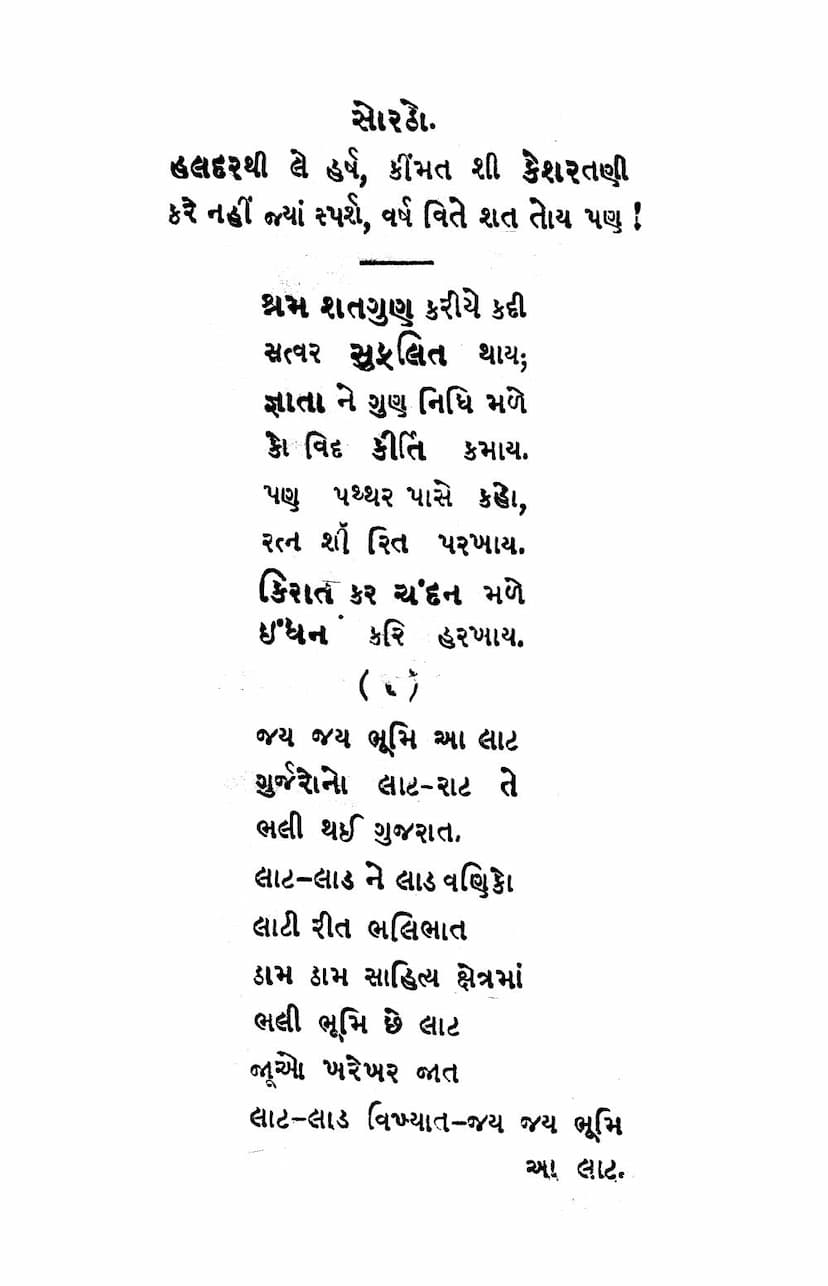Lad Avalokan
Added to library: September 2, 2025

Summary
Here's a comprehensive summary of the Jain text "Lad Avalokan" by Purushottam Lallubhai Mehta, based on the provided pages:
Book Title: Lad Avalokan (Meaning: A Review/Observation of the Lad Community) Author: Purushottam Lallubhai Mehta Publisher: Purushottam Lallubhai Mehta Publication Date: 1911 (based on page 7)
Overall Purpose: The book appears to be a historical and socio-cultural exploration of the "Lad" community, likely a sub-sect or a group primarily known for their mercantile activities, originating from or associated with the ancient region of "Lat" in Gujarat, India. The author aims to document their history, traditions, social practices, and contributions, with a particular focus on their evolution and current state in the early 20th century.
Key Themes and Content:
-
Origin and Identity of "Lad":
- The text establishes the connection between the "Lad" people and the geographical region of "Lat" or "Lata." It discusses the historical evolution of the name "Lat" and its linguistic variations (e.g., Larike, Lar).
- It delves into the geographical boundaries of the Lat region, describing it as a fertile land situated between the Mahi and Narmada rivers, extending towards the Saurashtra coast.
- The book explores the historical trade routes and connections of the Lat people, highlighting their maritime activities and trade with distant lands like Sri Lanka, China, Persia, Arabia, and even Greece. Bharuch (Barygaza) and Rander are identified as significant ancient ports associated with this region and its people.
-
Historical Context and Migrations:
- The text traces the historical journey and migrations of the Lad community, particularly during periods of political upheaval, such as the Muslim conquest of Gujarat (around the 13th-15th centuries).
- It mentions their dispersal to various regions like Khambhat, Surat, Jambusar, Konkan, and even Sind and other parts of India, indicating their adaptability and continued pursuit of trade.
- The book touches upon the influence of historical events and rulers on the community's settlements and practices.
-
Social Structure and Divisions:
- A significant portion of the book is dedicated to the internal divisions within the Lad community, specifically the "Visa" (Twenty) and "Dasha" (Ten) classifications.
- The origins and reasons for these divisions are discussed, acknowledging the lack of definitive historical records and presenting various legends and conjectures. The author notes that these divisions might have emerged due to social or economic reasons, or perhaps even as subdivisions within the larger Vaishya (merchant) community.
- The text also mentions the role and history of the Khedawal Brahmins who served as the Kul-gurus (family priests) for the Lad community, detailing their association and a significant historical event where they were expelled from Khambhat by Kalyanrai.
-
Notable Personalities and Families:
- Chapter 8 provides a detailed account of the "Haribhakti" family, tracing their lineage from Laxmidas Seth and highlighting the contributions of Harihbhai and Bhaktibhai. It narrates their business acumen, rise to prominence during the Peshwa and Gaekwad eras, and their philanthropic activities.
- Maganbhai, a prominent descendant from the Haribhakti lineage, is presented as a respected philanthropist, social reformer, and contributor to the community's progress.
- The history of Kahanadas, a devout Vaishnavite from the Lad community who played a role in political affairs and artistic endeavors during the Solanki dynasty, is also discussed.
-
Cultural and Religious Aspects:
- The book delves into the customs, traditions, and religious practices of the Lad community.
- It critiques certain contemporary practices, particularly child marriage and dowry (Kanyavikray), lamenting their negative impact on society and individuals. The author advocates for educational reforms and a more progressive approach to social issues.
- The importance of maintaining community unity, overcoming internal discord, and engaging in collective welfare activities like establishing funds for education and supporting the needy is emphasized.
- The author stresses the significance of adhering to religious principles and the role of good conduct in achieving societal progress.
-
Critique of Current Practices and Call for Reform:
- A significant part of the book is dedicated to critiquing the perceived decline in the Lad community's values and practices in contrast to their glorious past.
- The author expresses concern over the erosion of traditional virtues, the rise of materialism, extravagant spending on social ceremonies, and the decline in religious observance.
- There is a strong call for community reform, emphasizing the need for education, unity, and the adoption of modern, progressive practices while retaining core ethical values. The author encourages the establishment of community conferences and organizations to foster progress.
-
Statistical Data:
- The book includes statistical information from the 1911 census regarding the Lad population in various districts of Gujarat and beyond, differentiating between Visa and Dasha subdivisions and also mentioning Lad Shravaks (Jains). It also provides data on the educational status of the community.
Dedication and Foreword: The book is dedicated to Shri Manganbhai Purushottamdas (Haribhaktiwala), Nagar Seth Saheb, residing in Vadodara, recognizing his virtuous qualities and contributions to society. The author's foreword emphasizes the importance of education and the societal role of individuals who contribute to the general welfare.
Overall Tone: The book reflects a deep sense of pride in the community's historical legacy and achievements, coupled with a concern for their present state and a hopeful yet urgent plea for reform and progress. The author uses a blend of historical accounts, legends, social commentary, and religious discourse to present his findings and exhortations.